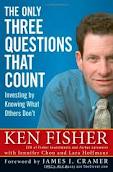The Only Three Questions That Count – The Wisdom of Ken Fisher Applied to Innovation Strategy
As innovators, we know that it is often productive to look for new connections between previously unrelated industries, technologies, markets, etc…
I was recently re-reading a very good book on investing strategy and it struck me that it contains some very applicable lessons for innovators. The book was Ken Fisher’s “The Only Three Questions That Count – Investing by Knowing What Others Don’t” – 2006
http://www.amazon.com/Only-Three-Questions-That-Count/dp/047007499X
You might be asking: What does investing have to do with innovation? In this case, the answer is: Quite a bit! A major premise in this book is that an investor is never going to beat the market, if they use the information that everyone else is using, in the same way everyone is using it. Also, much of what we think we “know” needs to be questioned to separate the folklore from the facts.
This absolutely applies to innovation. If your company knows the same things as your competitors, and if you are doing things the same way they are, then you are going to struggle to compete. The key is to become aware of this and do something about it.
There are three questions that Ken Fisher poses to investors, and all of these apply to both business strategy and innovation strategy:
1) What do you believe that is actually false?
2) What can you fathom that others find unfathomable?
3) What is your brain doing to blindside you?
These are very good questions for innovation leaders to be asking themselves on a regular basis:
1) What do you believe that is actually false? – We all fall into this trap of developing internal “tribal knowledge” that is accepted as truth, when in fact it may be false. What does your team “know” to be true that really should be questioned? (some ideas below to get the ball rolling)
- Customers really don’t want ________________ (fill in the blank)
- Everyone wants ________________ (do they really?)
- That startup competitor really won’t amount to anything
- Our products are best because _______________
- Our competitor’s products are inferior because _______________
- Our competitors will never figure out how to _______________
- ________________ is impossible
2) What can you fathom that others find unfathomable? – This is a really important one for an innovative company. You have to learn how to do things that others can’t do. You must learn things about your customers that nobody else sees. You must see relevant connections where others don’t.
- What can your team do that nobody else can? How will you leverage this?
- What does your team need to learn how to do?
- How will you get unique insights about your customers that your competition doesn’t have?
- What technologies, manufacturing processes, cost advantages, etc… can you gain access to; that your competition can’t? How can you create more of these unique advantages?
3) What is your brain doing to blindside you? – How are pride, overconfidence, and confirmation bias; all conspiring to blind your team to important information around them?
- We all seek out information that supports our view of the world, and we discount information that doesn’t fit with this viewpoint. How is this “confirmation bias” at work in your organization? What data are you rejecting even though it is right there in front of your face, because it doesn’t fit with what you “know” to be true?
- We all have pride in our products, brands, and companies. How is this pride causing you to discount what is happening elsewhere?
- All projects have champions who believe their product will be a winner in the market. However, in fact many of these products won’t win. How is this overconfidence impacting what projects are in your portfolio?
Ken Fisher developed this framework with investing in mind, but if you read his book more broadly, you will find it very applicable to innovation strategies as well. If you are involved with innovation and are also interested in investing, then you’ll get twice the bang for the buck out of this book.
Eric Bartsch
@ChanuteGroup

